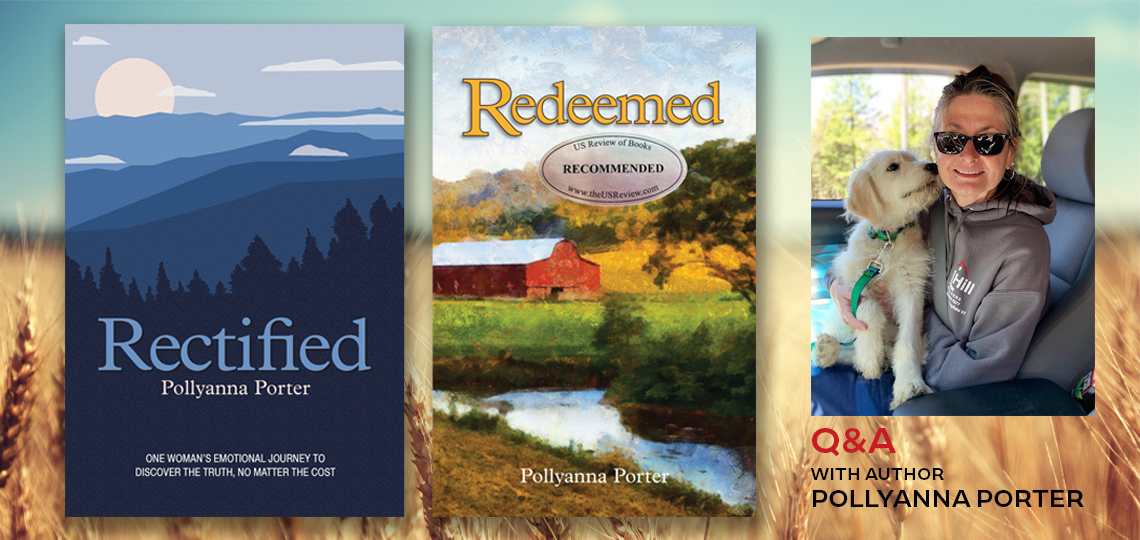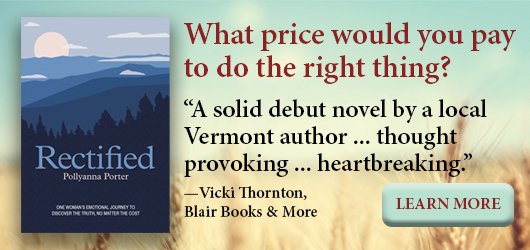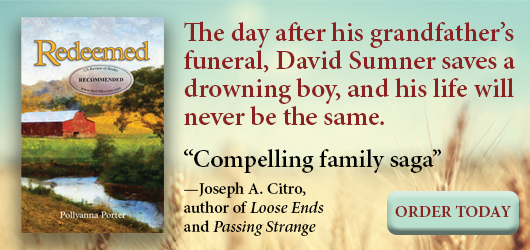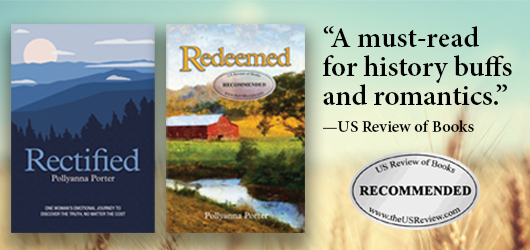Can the wrongs of the past ever truly be made right?

Executive Editor Matt Sutherland Interviews Pollyanna Bladyka, Author of Redeemed and Rectified
You can take the teacher out of school but you can’t take her thirty-plus years of interacting and educating children out of the teacher. Or her understanding of the parent-child relationship. What say she put that knowledge to good use in fiction?
And that’s exactly what Pollyana Bladyka did in the novels Rectified and Redeemed—at an astonishly high level, according to Foreword’s Executive Editor Matt Sutherland. With art theft, childhood trauma, mother-son estrangement, and so much more imagery from the books fresh on his mind, Matt connected with Pollyanna for the following conversation.
Your first novel, Rectified, is multilayered and unsuspecting. Sara has an incredibly rich, often conflicted inner dialogue going at all times. She experiences trauma in her marriage, and is painfully honest with her feelings. I think it’s fair to say, as you write about Sara in the postscript of Rectified, that “guilt is at the center of my why.” Her relationship with her son, Michael, is perhaps the most important thing she has. Can you talk about the power of mother-son relationships?
I’ll broaden that to talk of the power of mother-child relationships in general because Sara, in Rectified, could just have easily had a high school daughter she becomes estranged from. I chose for her to have a son because I wanted to contrast her son’s wonderful childhood to the devastating childhood of the three Larson brothers. The early scenes in Rectified describe Sara and her son, Michael’s, loving relationship. Since Sara is the primary parent home while her husband, a consultant, travels, I wanted to convey their special bond right up into Michael’s young adulthood.
Redeemed, my second book, also centers around the mother-child relationship; David’s inability to get beyond his mother’s abandonment, and Rachel’s absolute fear and then joy at having “her babies” safe and close by. I hope, in both books, I conveyed this powerful bond because it was my intention to do just that. As for the inner conflicted dialogue of both Sara Scott in Rectified and Rachel Dunne in Redeemed—they’re mothers, it’s a given. Mothers never feel like they’re doing anything right or that they’ve done enough!
You alternate chapters in Rectified into a time frame of present/past, recounting Sara’s journey with the Larson boys and then her new life, a year later, in another state and all alone. What were your reasons for choosing this set up?
I wanted to portray all the facets and consequences of Sara’s actions in giving up everything for the sake of stopping a heinous crime. To do that it was necessary to highlight her loving family and work life and then, in the present, to show that all of that was lost. Rectified is actually two stories in one; Sara’s discovery of sexual abuse and her involvement in stopping it and then how she manages to begin a new life in Bristol, Maine. The two timelines remain separate until there is forgiveness. While Sara meets new friends and a new lover in Bristol, the past and all it entails has caused estrangement from her son. Again, there’s that power of mother-child relationship. Sara can’t be truly happy until her son has forgiven her and has accepted her new life.
In your second novel, Redeemed, David Sumner enters the Dunne family’s life when he heroically saves ten-year old Tommy Dunne from drowning. From there, over the course of weeks, Rachel and David gradually become friendly, even flirtatious with each other in a few half-innocent encounters and chance meetings. The tension builds. And then, the morning after a disastrous date night with friends, David resolves to pursue an all-out relationship with Rachel. So, just sixty or so pages in, you ask readers to steel themselves for a possible affair, if not a marriage blowing up. But very soon, the book turns in a completely unexpected direction. Actually, multiple directions. Can you talk about how you conceived this story and the decisions you made in how to tell it?
Rectified was all about an affair, and a marriage imploding because of a course of action Sara takes to rectify a terrible wrong. So, in writing Redeemed, I wanted to make sure the plot didn’t go in that direction. In fact, I purposely chose to have a strong marriage anchor Rachel Dunne against the charismatic David Sumner. I wanted to tell this story of intrigue (art stolen, hidden, and returned) not at the expense of a marriage ending, but rather from the core bond that exits between mother and child, grandparent and grandchild.
This story, like my first book, is one that’s been kicking around in my head for years and stems from my many years of teaching. I’ve experienced firsthand children being raised by grandparents and how the absent parent(s) may be perceived by the child. The mystery in Redeemed took shape as I wrote it. And I did have a very real “moment” hidden in a milk cellar when I was a kid!
It took me most of the novel to realize it, but at the end of the day, Redeemed is a heartwarming love story. Was that one of your goals?
Yes, absolutely. Redeemed is totally about love; the love we build with our mates, the love we hold for our children, and grandchildren, the love we lose when someone passes, the love we find unexpectedly, the love we develop for a place, and even the love we grow to hate. I wanted the reader to see and understand that the David Sumner eleven years out after meeting Rachel that fateful morning of the near drowning, was very different. He’d grown to recognize the love he failed to see and accept most of his life. It was then, at that point, that the unexpected happened.
David is an art dealer, and his success is based on how well he can cultivate wealthy buyers. He was raised by his grandparents, who have both passed, and has no other family that he knows of. He also has a very, very active dating life, with many if not most of his relationships involving married women. He is quite coldblooded and doesn’t seem too conflicted over his serial philandering. Even so, his assistant, Emily, thinks David’s behavior is more an issue of self-loathing or self-hate. And David is also highly principled in his art dealings, unlike many of his competitors. What interested you while creating this male archetype for the story?
I wanted David to be someone you loathe but then someone you can root for so I had to make him complex. As a teacher of over thirty years, I understand how adverse childhood experiences play into a person’s make-up. David was “left” at his grandparents’ farm and grew to question his very self-worth. Emily, his assistant, saw this, saw that David didn’t like himself. It was only through counseling that David started to understand his negative self perception. The mystery of the art hidden and found gave David the opportunity to work through these negative beliefs and actions, to actually “redeem” himself as being worthy.
Similarly, adverse childhood experiences play out in my first novel, Rectified. The family that Sara Scott becomes involved with has suffered terribly (sexual abuse) and it’s because of her that the Larson boys have a chance to “move on.” As I stated earlier, I purposely juxtaposed Sara’s son, Michael’s, upbringing against theirs to show the stark difference in many children’s lives. Teachers, of course, see these differences, but many people, removed from daily interactions with a wide array of children, don’t. Both of my books have the quality of “There, but for the grace of God, go I” because of my work with children and parents that have struggled.
Rectified is from the angle of a teacher and you were a teacher. Yet, from the nitty gritty of high-end art deals to Hitler’s scheme to steal Europe’s fine art to the intricacies of mixing oils and pigments on an artist’s palette, Redeemed reveals your hefty knowledge of art history, painting, and gallery life. What gives?
Believe me, I knew nothing, having only experienced the proverbial water colors at the kitchen table! I researched all of this and also spent time talking with my cousin, Mathew Blackwell. Matt is a well-regarded artist in New York City and gave me great background knowledge, especially regarding Soho and the years he was an art handler. I viewed tutorials online on how to paint with oils and charcoal drawings and I became fascinated with the art world, especially stories on art brokers like Inigo Philbrick and art fraud, like what Alec Baldwin experienced.
Rectified was much more up my alley. But I love to read and the Monuments Men and their mission was the perfect way to add in the mystery of the stolen art and David’s grandfather being so much more than a simple, non-descript man. Part of David’s journey was to become humble and learning about his grandfather’s role in Hitler’s pillaging provided that. There is a wealth of information out there on the missing art and artifacts that Jewish families are still looking for. The key to all this research though was to bring it in naturally through dialogue between the characters. I think I achieved that.
You wrote Redeemed in short chapters, each in the voice of a different character: Rachel, David, Tom, Tommy, Emily, Amy, and Sidney. Was it tough to keep track of all those voices in your head? Were any of the characters more difficult than others?
I wrote Rectified in the first-person narrative of Sara. While that creates an intimate bond with the reader, it can be limiting because all of the action must filter through that one character. I knew I wanted to have more opportunities to tell the story of David (and Rachel) in Redeemed so I began with the two voices. But, as you noted in your question, those voices grew to include five more! It wasn’t hard to keep track of them, I just had to make sure that each voice was distinct, realistic, and consistent throughout the novel.
Much of the novel is in David’s voice; a man from the age of 39 to 51. He was the hardest because I needed to figure out his take on everything without falling into what’s perceived as stereotypical male thoughts, actions, and behaviors. In retrospect, I think David’s growth had nothing to do with gender. He was human, period.
I just want to add that like David in Redeemed, the voice of Jason Larson in Rectified was also challenging. He was a teenager that had to appear calm and thoughtful, yet painstakingly honest with Sara while recounting the trauma he and his brother suffered at the hands of the most powerful man in town. I worked hard on Jason’s voice, especially in his heartbreaking revelations to Sara.
My favorite voice in Redeemed was Amy’s. I taught middle school—Amy was easy!
Amy first appears breastfeeding and grows through toddler stage and beyond, but we are given hints that this is no ordinary child, her prescience and intuition is preternatural. Have you met a child like this? What about Amy’s life-after-death and reincarnation revelations?
I debated this about Amy in the early writing of Redeemed. I felt I wanted to make her wiser beyond her years, even though she is the youngest of all the main characters. I grew up in the 70’s and my mother was a beautiful, divorced woman who delved into macrobiotics, reincarnation, and Transcendental Meditation. My sisters and I were open to all these new ideas. Amy’s sixth sense grew out of these wonderful memories of my childhood. When my editor read the manuscript, I asked for her thoughts on Amy’s psychic abilities. “It works!” she replied. I also knew Amy would end the story, that Amy’s voice would be the final voice.
Grief. Stages of it. The intimate language of therapy. Again, you show your hand as someone—perhaps, reluctantly—versed in recovering from the loss of a loved one. You used the grieving process as an effective way of showing how certain people put their life on hold. Can you talk about the role grief plays in the book?
In Redeemed, Rachel’s solid marriage, the one she’s built her life and the life of her two children on, is rocked when her husband is diagnosed with cancer. His eventual death results in a fissure between Amy, who is now a middle schooler, and her. Amy is angry while Rachel is depressed. Young Tom, now back at college, is in acceptance and actually falling in love. The three, all at different stages of grief over the death of their father and husband, must find their way back to the common ground that was once their family. David, the arrogant, womanizing art broker has also experienced upheaval. He re-enters their lives as a different man and together all of them find their way forward.
I just want to add that the utter depths of despair and loneliness Sara experiences in Rectified, as she settles into a new place and has no contact with her son, is very much like grief. For her, the loss of Michael manifests into two emotional breakdowns. And, like a grief support group, Sara is able to take comfort from two new people in her life who understand and support her.
What’s next for you? Are you working on another R novel?
Yes, another R novel is planned! I retired from teaching in June of 2020. Rectified was published in 2021, Redeemed at the end of 2022. My third novel will be some time yet. I like to write in the colder months and right now spring has finally sprung in the northeast. But I think my readers will be patient and ultimately happy. It will once again take place in fictional Langdon, Vermont, as the other two have, but with different yet equally interesting characters. Small-town living provides rich fodder for my stories, and it’s what I know best. What I’ve been able to do, and will do again in my third R, is have characters from the previous book pop into the new story, briefly, like in real life where everyone knows everyone. Small towns provide “two degrees of separation” instead of the usual six!
In both Rectified and Redeemed, I started by writing the beginning and the ending first. I knew where I wanted to end up but the “getting there” was interesting, and not always what I expected. My characters led the way. My third novel has a strong start, with lots of possibilities.
As a relatively new writer of commercial fiction, my goal is to be honest, even if it paints my characters in an unflattering light. Realistically, we all have done things or acted in ways we’re not proud of. Humans are complex, and sometimes unpredictable. Being honest provided me with rich characters in Sara Scott and Jason Larson, (Rectified), and in David Sumner and Rachel Dunne, (Redeemed). My second goal is to provide my readers poignant story lines in a fast-paced narrative. I want to keep you wanting more! Many of the reviews written on my two novels thus far have expressed just that—they weren’t ready to say goodbye to these people of Langdon, Vermont. Fortunately, I can say, they won’t have to because more of Langdon is on the way.
Matt Sutherland



